By Beatrice Appay, PhD, Holistic Health Practitioner, Yoga Teacher & Qigong Instructor
The Story behind the Five Tibetan Rites
The Ancient Secret of the Fountain of Youth was revealed in 1939 by Peter Kelder in The Eye of Revelation. In this little book he tells the story of his encounter with a retired British Army officer, Colonel Bradford (a pseudonym). When stationed in the Himalayas in the early 1900’s, he heard rumors about Tibetan monks (Lamas) who knew how to reverse the effects of age and improve health conditions.
After his retirement from the Crown diplomatic corps, Colonel Bradford searched and searched and finally found the secret Tibetan monastery (Lamasery) where these monks lived. He stayed for two years and learned many of the Tibetan Lamas’ secrets for health and rejuvenation. Shortly after returning from Tibet, he taught Peter Kelder how to practice the 5 Tibetan Rites and, together, they started a class to see what effects these Rites had on people with different health conditions.
Millions of practitioners
To date more than 2 million copies of various versions of Kelder’s 1939 book have been published, and millions of people have begun practicing the Five Tibetan Rites. In essence the Rites are a sequence of physical exercises renowned for their anti-aging benefits and often considered as a form of Tibetan Yoga, or a yoga sequence that activates the chakras. Kenyan-born Carolinda Witt and American medicine-hunter and yogi Christopher Kilham fostered the Rites’ popularity by writing about the 5 Tibetans and introducing them to thousands of students. Along with numerous other writers and teachers, they have contributed to making this unique exercise program well-known and celebrated internationally.
Although superficially they may appear to be a mere repetition of familiar yoga poses, the Five Tibetans Rites are far more than simple sequences of asanas, and they certainly do not duplicate any other practices.
The benefits of the Five Tibetans
Renowned for their rejuvenation and invigorating powers, the Five Tibetan Rites are easy to perform, taking only 10 to 15 minutes per day for great, energizing results. They can be performed with other practices or just by themselves and still be very effective.
Many practitioners, medical doctors and yoga teachers have documented their considerable health benefits.
The Five Rites are said to:
- Slow down the aging process and rejuvenate the body
- Improve physical strength and flexibility, endurance and vigor
- Enhance vitality and energy
- Generate a sense of wellbeing and harmony
- Relieve tension and stress, reduce anxiety
- Improve sleep and help deep relaxation
- Improve mental health
- Strengthen the cardio-vascular system and better circulation
- Stimulate the endocrine system
- Help weight loss and hair growth (with added instructions)
Easy, simple and accessible
The Five Tibetans are easy to learn and practice. They can easily be integrated into a yoga class or be just a short daily practice. Furthermore, they can be done by beginners, although some precautions must be taken. Professional guidance of a yoga instructor is certainly recommended in order to avoid injuries, in particular when practiced for the first time.
The modified 5 Tibetan Rites
Since Peter Kelder published the illustrated Five Tibetan Rites, numerous versions of Kelder’s book have been published, often with additions and/or omissions.
However, we can now have access to the original words of Peter Kelder in a 2008 edition of his book edited by J.W. Watt, so we identify the modifications that have been introduced over the years and that have influenced the ways the 5 Tibetans Rites are practiced nowadays.
This is prime information that allows us today to go directly to the source and to practice the Rites as they are meant to be practiced with as few alterations as possible in order to maximize their effectiveness.
For example, some Kelder’s instructions have been:
- omitted, such as the forward bend in Rite 3;
- or added, such as sequences between the Rites or breath control;
- or misstated, such as the locations of the seven Vortexes or the confusion with the Chakras.
At its essence, the aim of the 5 Tibetans is to revitalize the main centers of energy in the body.
How to do the 5 Tibetan Rites
Rite 1 : Spinning
The First Rite is a simple one. Its purpose is to speed up and restore harmony between the 7 Vortexes
- Stand up with arms stretched out, horizontal to the shoulders and spin around on the spot, in a clockwise direction, until you become slightly dizzy. One must not do this exercise to excess.
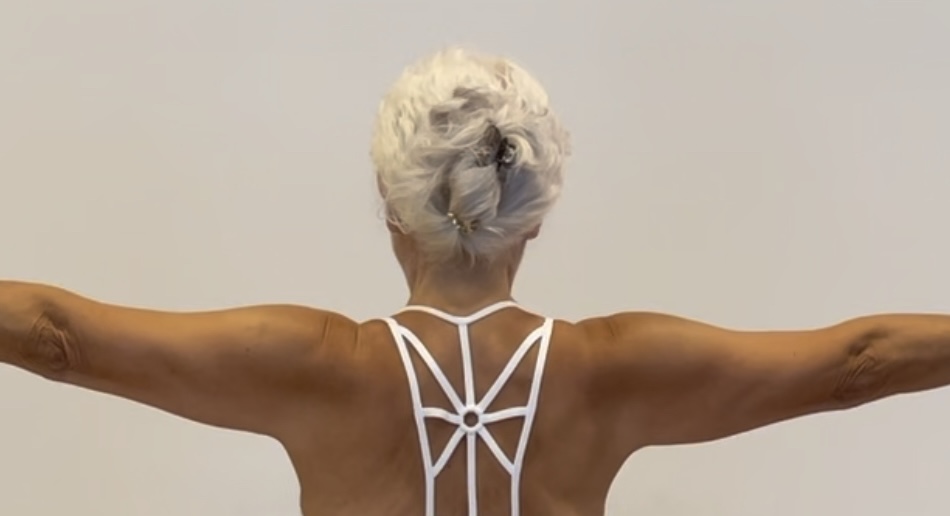
Rite 1
There is no recommended speed. You can turn slowly and still enjoy great benefits. Never turn faster than what feels safe for you. The number of spins varies, a few rotations will do for a beginner, more after some practice. Contrary to the Whirling Dervishes of Sufism who spin around for long periods of time, the Lamas consider that spinning excessively will have adverse effects on the body. Although there is no specific maximum number of revolutions, 21 repetitions are basically all that is needed even for advanced practitioners.
Rite 2: Head and leg raise
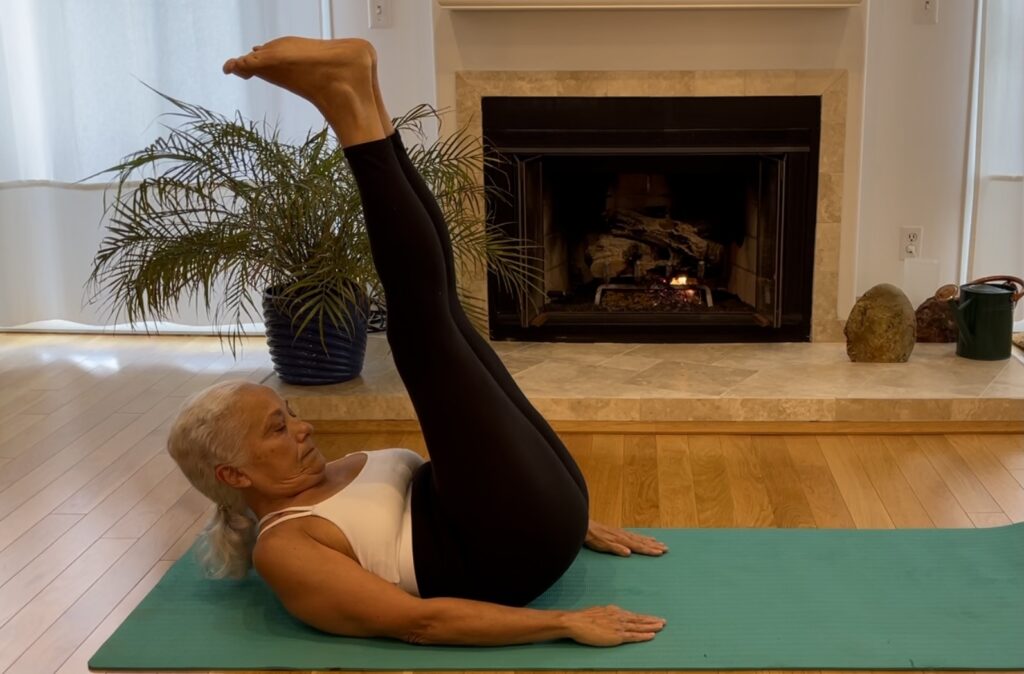
This second rite provides further stimulation of the 7 Vortexes and is even simpler than the first one.
- Lie flat on your back. Arms alongside the body, hands turned down, fingers together pointing slightly inwards, legs together. Lift your legs and head at the same time, slowly, bringing your chin toward the chest and raising the leg straight up over the body toward the head, without bending the knees. Hold for a moment or two and then slowly lower your legs and head to the ground. Let your entire body relax completely for several moments before repeating the second Rite.
Neither Kelder or Bradford makes any recommendations regarding breathing, so they are silent on basic yoga breathing patterns such as deep breathing, exhaling or inhaling. Yet breathing is certainly important to the 5 Tibetan Rites, and controlled breathing is central in the Sixth Rite particularly related to the channeling of sexual energy. It can be assumed, as J. W. Watt does in his edition of Kelder’s book, that breathing normally during the 5 Tibetans will automatically be the best way possible during each rite, letting the body find its own breathing rhythm.
Rite 3: Kneeling forward bend and backbend
The Third Rite resembles the Camel pose, the well-known backbending posture when kneeling. The forward bend is often omitted in many versions of Kelder’s book, although it is quite important in the Third Rite.
The Third Rite should be practiced immediately after Rite 2. It is also a very simple one.
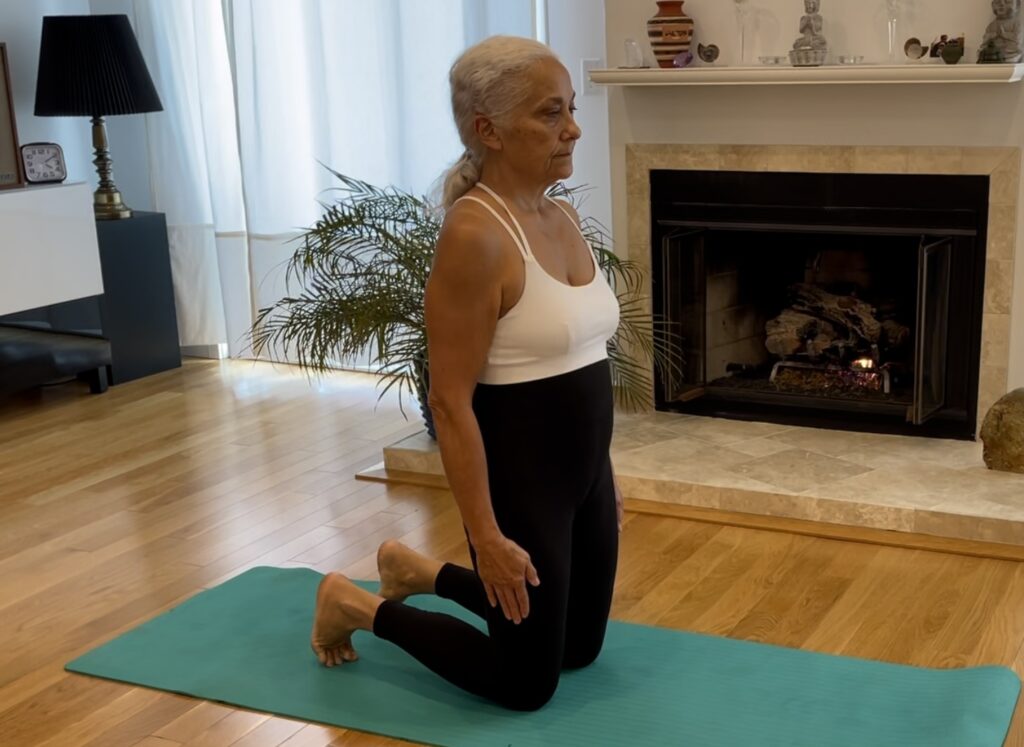
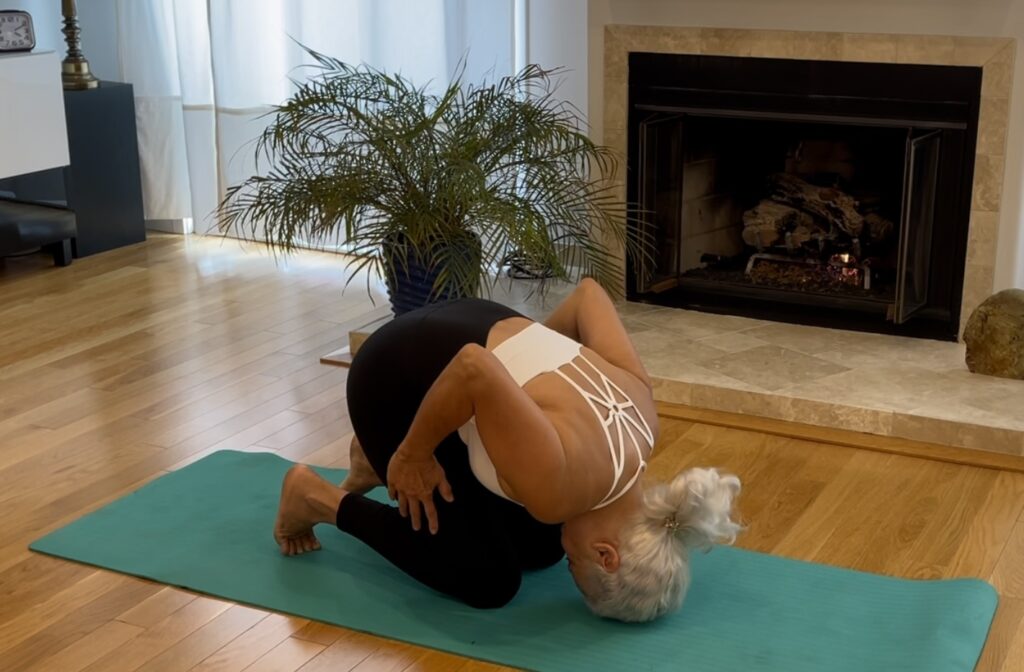
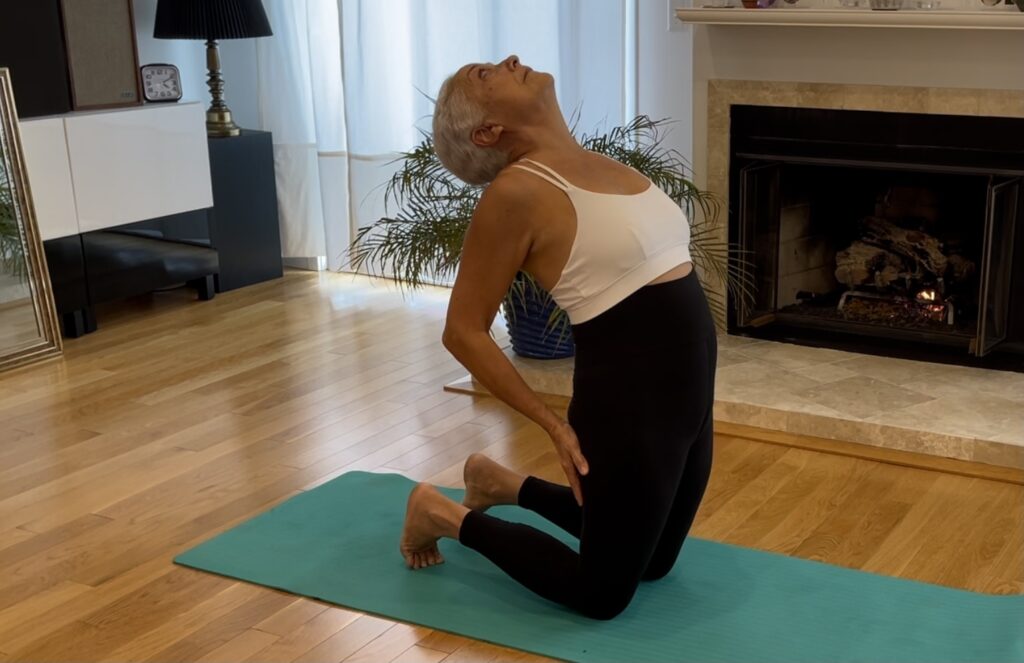
- First position : kneeling with toes tucked under, keep your arms and hands on the side of your thighs.
- Second position: incline your head towards your chest and lean forward as far as possible.
- Third position : lean backward as far as possible and at the same time let your head be lifted and go backward as far as it will go (Be cautious to perform this movement slowly, in particular for beginners, to protect your neck and lower back). Then bring your head up along with the body and start the Rite all over again.
This Rite is used to activate specific Vortexes and is particularly important for the reproductive organs.
Bradford recommends performing the Third Rite with your eyes closed in order to do it at your own rhythm and not be distracted.
Rite 4: Moving Tabletop
This Fourth Rite might seem difficult at the beginning, but after a while it is going to be as easy as the others.
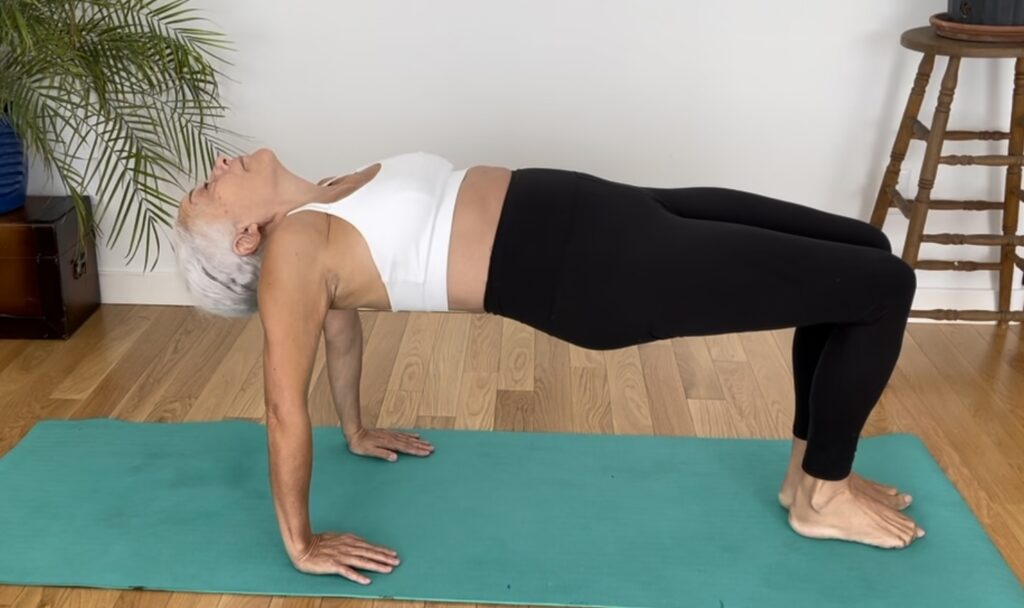
- First position: sit straight, legs straight, with the back of your knees as close as possible to the floor, hands flat on the ground, fingers together pointing slightly outward, chin toward the chest, head forward.
- The second position is the tabletop position: gently lift your body to the horizontal whilst moving your head backward without forcing, knees bent until the front of the body is flat, parallel to the floor. Hold the position while tensing every muscle in the body before relaxing and returning to the first position. Perform the Rite again.
Rite 4 activates the Vortexes F & G located in the knees, D on the waistline, E in the reproductive organs and C at the base of the neck.
Some older practitioners might find it difficult to lift their body even slightly off the floor. They should not feel discouraged because there are a number of strategies to approach this Rite in order to build strength in the glutes and core muscles, and loosen up the shoulders and ankles. With time, even much older people will be able to perform it many times in a row!
Rite 5: Upward-Facing Dog and Downward-Facing Dog flow
The Fifth Rite activates all 7 vortexes. It is a variation of an Upward Facing Dog and Downward Facing Dog flow.
-
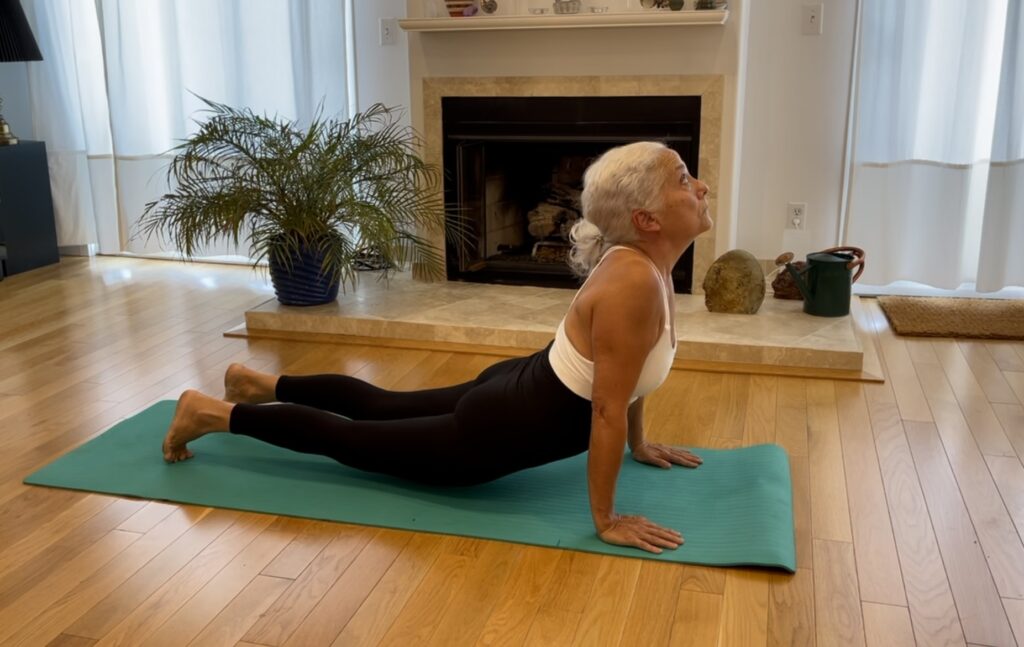
Upward-facing dog, Rite 5 position 1 First position: arms straight with your hands flat on the floor, shoulders width apart, legs stretched out behind with the toes tucked under, hip width apart. The legs remain off the floor. The head is brought forward and the chin comes against the chest (again at the beginning be careful with bringing your head forward). Let the body come gently to a “sagging” position and bring the head up and backward gently as far as possible (again be careful not to force the head backward to protect your cervical vertebrae and not to let your body “sag” too much to avoid lower back pain. Protect your lower back by slightly engaging your abs).
-
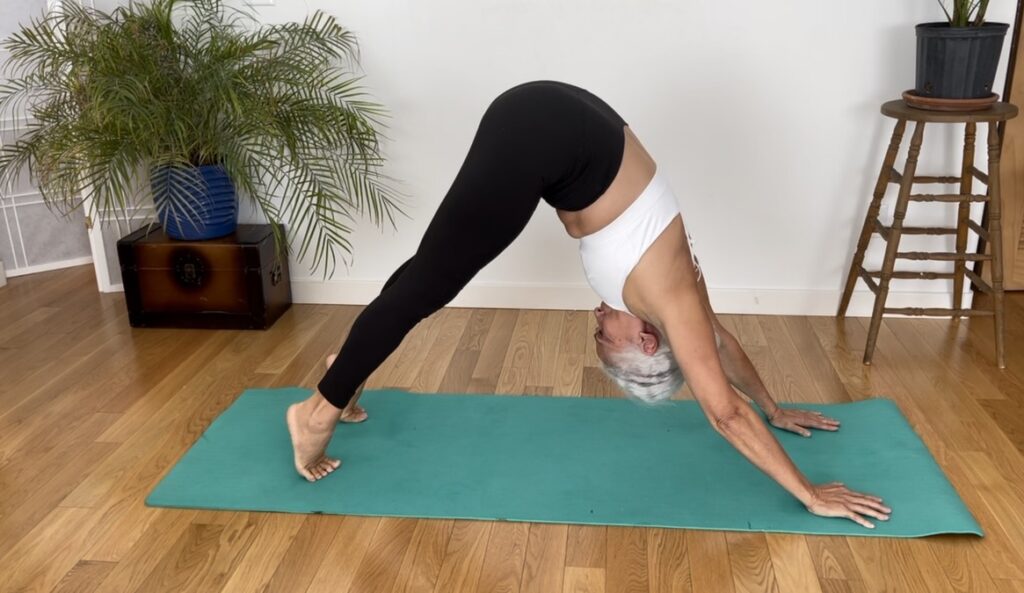
Down-facing dog, Rite 5 position 2 Second position: push on your arms, hands and shoulders, whilst lifting the hips upward as much as possible, high on the toes, chin toward the chest. Hold the position and tense the body for a little while before returning to the first one.
After some practice, the muscles should be tensed for a moment when the body is at the highest point and again at the lowest point.
Precautions
Precautions must be taken, particularly when beginning your practices:
- when moving your head forward and backward, avoid doing this to excess in order to protect your cervical vertebrae.
- when letting your hips “drop” in Downward Dog. It is necessary to protect your lower back and lumbars. Do not engage in excessive back-bending (lordosis). This could provoke lower back pain or even injury.
- Do not hesitate to practice with a competent Yoga Instructor to avoid injuries.
“If one has been recently operated on for, say, appendicitis, or is afflicted with hernia, one should be very cautious in practicing Rites Two, Three, and Five. If one is very heavy, one should be cautious in the use of Number Five until his weight has been greatly reduced.”
It is important to understand that these Rites are NOT mere physical exercises or fitness practices, nor even a subset of yoga practice. They can be practiced by themselves in a morning routine or easily integrated into a yoga practice with great benefit, as long as their specific movements are understood and followed in order for them not to lose their potential.
The 5 Tibetans method : a full 10 minute program over 10 weeks
This is a daily routine that engages the full body and won’t take more than 10/15 minutes of your time, even at the beginning.
We do recommend taking the necessary time to progress gently – and respect this progression to build up strength and stamina, from 3 repetitions of each Rite to 21 repetitions over a period of 10 weeks. And from there, to continue this everyday morning routine onward.
Here is a full program of 10 weeks, beginning with the 3 repetitions and adding 2 repetitions each week.
- Week 1: 3 Reps for 7 days
- Week 2: 5 Reps for 7 days
- Week 3: 7 Reps for 7 days
- Week 4: 9 Reps for 7 days
- Week 5: 11 Reps for 7 days
- Week 6: 13 Reps for 7 days
- Week 7: 15 Reps for 7 days
- Week 8 : 17 Reps for 7 days
- Week 9: 19 Reps for 7 days
- Week 10; 21 Reps for 7 days
The maximum is 21 repetitions and it is not recommended to do more in order to avoid adverse effects.
We who take ourselves in hand and make new creatures of ourselves in every imaginable way, each is doing marvelous work for mankind everywhere.
By practicing the 5 Tibetan Rites we are not only improving ourselves but helping the others in our lives.
——————
References:
(1) The first known edition of The Eye of Revelation (The New Era Press, Burbank, California, 1939) is not easily accessible. The New York City Library retains the only original copy we know of.
- To access Peter Kelder’s original words, I highly recommend the book published and edited by J. W. Watt in 2008 The Eye of Revelation. The Ancient Tibetan Rites of Rejuvenation by Peter Kelder, The True Tibetan Rites revealed From a Long Lost Manuscript.
- 6 years after the publication of the Eye of Revelation in 1937, Peter Kelder republished it with added information (publication date : 1946). This document has been known as the “lost manuscript”.
- J. W. Watt publication in 2008 is by far the most accurate edition of Kelder’s writings. J.W. Watt is an antiquarian bookseller and writer, who discovered this lost work after years of research. His analysis and comparison of the different editions of the Eye of Revelation and The Ancient Tibetan Rites of Rejuvenation allows us to understand how the Rites have been altered overtime and lost some of their potentiality. To come back to the source is essential, in my opinion, and J. W. Watts allows it. This is certainly my favorite edition of Peter Kelder’s work, accurate and precise.
(2) Other publications and sources:
1985, 1998, Book 1 &2 , An augmented edition of the Eye of revelation and best seller Ancient Secret of the Fountain of Youth by Peter Kelder, foreword by Bernie S. Siegel (Doubleday)
1994, 2011, The Five Tibetans, Five dynamic Exercises for Health, Energy and Personal Power, by Christopher S. Kilham, Healing Arts Press
2010, 2021 The Eye of Revelation, 1939 & 1946 Editions Combined, by Peter Kelder and Carolinda Witt, UnMind Pty, Australia
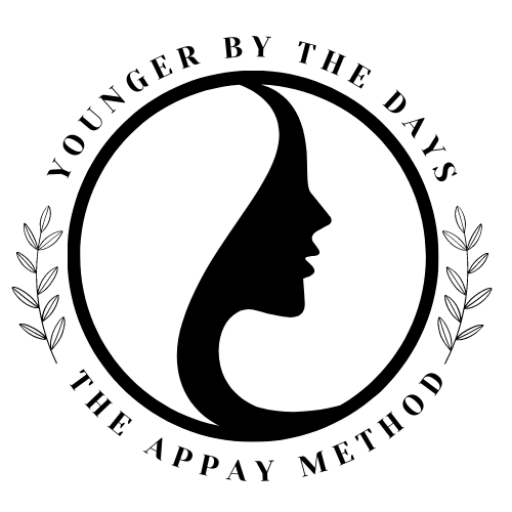


That’s a very useful article, thank you!